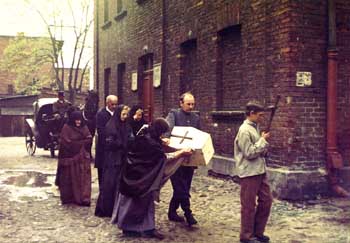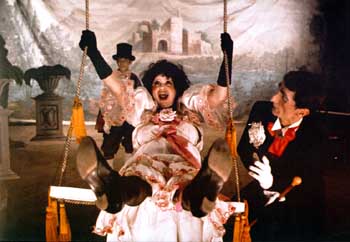
Wajda's use of Contrasts
Aesthetics and Style
by Dr.Wiesław Godzic

|
Wajda's The Promised Land is a film that presents a satanic city. a Moloch. Though it lacks elements directly connected with painting, its visual style constitutes a combination of antithetical elements and generates tension through the presentation of contrasts and appositions. On the one hand we can see fire, smog and fog, on the other - the stylish interiors and rich architecture of nineteenth-century Łódż.
Dynamic camera movements as well as the camera's swinging motions create an impression of a city overcome by the infernal forces: the story is punctuated by shots of flames and fires. Wajda's favorite colors are brown and dark red which symbolizes danger, anarchy, passion and revolution. Some human characters in the film remind one of monsters.
The film's rhythm is created by dynamic contrasts between two artistic visions: a phantasmagoric grotesque and social realism. In the closing scenes of the film, these visions overlap - in this manner Wajda reveals his ironic view of the hero's social success.
In 1977, in a New York City interview, Wajda said: "The job of film-maker seems to be very attractive - it combines the physical with the mental, concrete action with inspiration. Yet, there is something infantile about it as well. Like playing with toy soldiers. This first occurred to me when I was directing a battle scene. It was as if I were maneuvering tin soldiers, a children's game. I had a similar feeling while directing erotic episodes - as if I were trespassing into someone's intimate experience".
With regard to the cinematography:
Wajda was able to use natural settings. In 1974, there continued to exist in Łódż some factories that had been operating since before the turn of the century. Also, the mansions of the industrial barons had been maintained. As a consequence, it proved possible to shoot the film in existing buildings. The use of the three camera crews, each headed by remarkable artists made possible to shoot the film very quickly.

|
The movie is spectacular and genuine, but it hardly obeys all the rules of film narration. Wajda was capricious in his narrative technique, he was looking for effect. On the one hand; everything in this film conforms to the aesthetic norms of the cinematic medium (leading characters, changes in the relationships between them; their goals, the basic narration). On the other hand, the portrayals are vivid - too vivid, and many scenes are violent - probably too violent. It is a perfect example of Wajda's baroque style, of his tendency for permanent exaggeration and of his toying with the aesthetic means of expression.
There is, in the film, a theater scene in which an actress on the stage swings to and fro in a swing. In true Fellini style, the camera is made to move, impatiently, with the swing's oscillations. Wajda uses, and over-uses, wide angle shots which destroy the illusion of reality and render the sequences oneiric, or dream like. He tests the very subtle limits of how sex can be portrayed, a risky initiative given the rather puritan traditions of the Polish cinema. Viewers are thereby confronted by baroque, or Roman style, sexual orgies overloaded with an erotic aura. Borowiecki's sexual attitude towards Lucy, the wife of a Jewish businessman, (played by Kalina Jedrusik - the most sexy Polish actress of that time) is perverse and naturalistic. These attitudes as well as scenes depicting their sexual intercourse in a carriage as well as in a train were shocking to Polish spectators who were not accustomed to such portrayals.
From the artistic point of view, The Promised Land it is a great, remarkable work of film art: full of contrasts and virtual incoherences which work together to build a masterpiece.
The above are edited excerpts of remarks made by Dr. Wiełsaw Godzic at a Polish Arts Club of Buffalo showing of Wajda `s film The Promised Land. Dr. Godzic is a Professor of Audiovisual Media at the Jagiellonian University in Kraków.
| info-poland | Poland in the Classroom | Reymont pages |
| Info-Poland a clearinghouse of information about Poland, Polish Universities, Polish Studies, etc. |